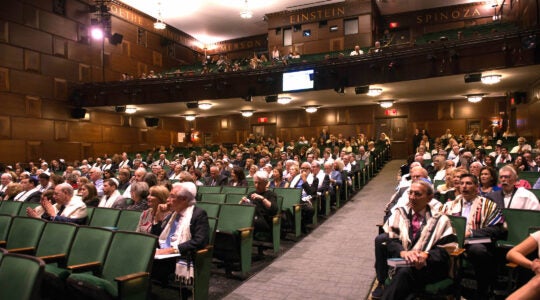Jerusalem — Gershon Baskin, the American-Israeli who helped broker the release of Gilad Shalit through his back-channel contacts with Hamas, said he hopes to keep that door open for future peace talks.
“I don’t think these issues can be negotiated in public,” he said. “People need to trust each other and not get bogged down for lack of trust.”
Baskin, founder and co-director of the Israel Palestine Center for Research and Information and host of a weekly radio program in Hebrew on All for Peace radio, pointed out that Shalit’s release was not his first successful negotiation.
“This back channel of mine also arranged for three cease-fires, including one in August,” he said.
Baskin identified his Hamas contact as Ghazi Hamad, the Hamas deputy foreign minister who has contacts with Hamas’ military wings.
“For two years he had been responsible for borders, and he had a relationship with the military wing,” Baskin said.
Asked in a phone interview what the next step might be to get Palestinian peace starts restarted, Baskin said that although his back-channel contacts represent “a door opening, there are a lot of complex things going on.”
He explained that some in Hamas are talking of holding internal elections to a ruling council. Sheik Ahmed Yassin, the founder of Hamas who was assassinated in 2004 when an Israeli helicopter fired a missile at him, had appointed its members.
“There are now younger voices in Hamas who are saying they want democracy,” he said. “I don’t know how they will do it, but I hope the democratic process they follow has a good ending.”
It proved to be a good ending for Shalit as well as the 25-year-old walked on his own power across the Gaza border and into Egypt Tuesday morning. He appeared thin, tired and white as a ghost — having been kept in an underground cell during his more than five years of captivity.
And in a surprise move, Egyptian TV held an impromptu news conference with him before he was allowed to enter Israel. He appeared gaunt and uncomfortable and his breathing was described as noticeably labored as he answered the questions, posed in English and translated into Hebrew. The interviewer said later that she had to repeat some questions several times because he appeared to have trouble concentrating.
It was reported that armed Hamas terrorists were in the area while the interview was conducted. One stood behind his chair wearing a black facemask and a green headband of Hamas’ military wing.
Shalit was asked if he would campaign for the release of the 5,000 Palestinians still held in Israeli prisons and if the experience had made him stronger. He replied that he would like to see the release of all prisoners along with peace in the Middle East. An Israeli TV anchor called the interview “borderline torture.”
Only after the interview, which was carried live around the world, was he turned over to Israeli officials and then given a medical exam. In addition to suffering from a lack of exposure to sunlight, doctors said he had signs of malnutrition.
Once he was back on Israeli soil, he spoke by phone with his parents for the first time since his capture. But before he was reunited with them, TV cameras in the Gaza Strip captured pictures of Hamas Prime Minister Ismail Haniyeh embracing returning Palestinian prisoners. He later called the release of 1,027 Palestinian prisoners for Shalit a “strategic turning point in our struggle against the Zionist enemy. It was thanks to our resistance that we were able to release the land and the people.”
When Shalit arrived by helicopter at an Israeli military base in central Israel, he was greeted by his family and Israeli Prime Minister Benjamin Netanyahu, Defense Minister Ehud Barak and military brass, whom he smartly saluted.
After greeting Shalit, Netanyahu said it was a “very difficult decision” to agree to such a lopsided prisoner swap that included the release of some Palestinians responsible for major terrorist attacks. But he said the government had the responsibility to bring him home.
“It is a cornerstone of our existence here,” he said.
Netanyahu pointed out that “senior Hamas leaders, including arch-murderers, remain in prison.” And he said others had been expelled or kept out of the West Bank “in order to impede their ability to attack our citizens. For years, Hamas strongly opposed those demands. But several months ago, we received clear signs that it was prepared to back down from this opposition.”
It was later reported that the U.S. State Department voiced objections to the release of some of the Palestinians released because it believed they still pose a threat.
Analysts believe Israeli Prime Minister Benjamin Netanyahu and Hamas agreed to the prisoner swap in part to undercut Palestinian President Mahmoud Abbas after his controversial appeal last month for United Nations membership. The action sidestepped bilateral talks with Israel, while making Abbas a hero for Palestinians.
No sooner was Abbas glowing from the accolades he received, than the Hamas deal stole the spotlight. Abbas could conceivably try to gain the spotlight again with a surprise agreement to restart negotiations with Israel. But without a settlement freeze from Israel and commitments to negotiate based on the 1967 Green Line, Abbas would risk undermining the credibility that he built by going to the United Nations.
With the peace process stymied, Abbas and Hamas might have more incentive to revisit the reconciliation agreement they signed earlier this year. The prisoner deal might give Hamas more leverage in horse trading with Abbas over a range of sticking points that couldn’t be resolved — such as a unity cabinet and the integration of security forces in the West Bank and the Gaza Strip.
On the other hand, moving toward a unity government without Hamas foreswearing violence and recognizing Israel and prior peace agreements could expose the Palestinian Authority to Israeli and American financial sanctions.
Baskin and other experts said Israel might decide to allow Hamas to strengthen its rule by “ending the siege” of Gaza, allowing more goods in and out and permitting the rebuilding of Gaza’s infrastructure.
“This situation [in Gaza] must be stabilized,” said Gidi Grinstein, the president of the Reut Institute and a former negotiator. “The Israelis understand that whether we like it or not, we are in a three-entity reality.”
The day before Shalit walked free from more than five years of Hamas imprisonment, an emotional debate over the lopsided prisoner exchange — Shalit’s freedom for the release of 1,027 Palestinian prisoners in Israeli jails — erupted as Israel’s Supreme Court heard petitions against the deal. (The appeals were denied.)
While waiting in line to be checked by security guards at the courthouse, Alan Bauer pulled back his shirt cuff to reveal a scar on his wrist from shrapnel he received when a suicide bomber wounded him and his son eight years ago.
“Terror victims have never been against the release of Gilad Shalit,” he said. “We’ve been made out to be against it somehow.”
But he has concerns.
“What if the people released kill other people. Will the Shalits and Netanyahu take responsibility for it?” he asked. “Of course not. The second thing we’re concerned about is: what about justice for us?’’
Standing just behind Bauer in line, was Yossi Tsur, one of the petitioners against the prisoner swap. His son Assaf was killed in a Haifa bus bombing in March 2003. Wearing a black shirt with his son’s picture as a three-dimensional Andy Warhol painting, he summed up the sentiment among many of the victims of terror attacks.
“We feel like they’ve betrayed our children,” he said.
Not far away, at the bottom of the driveway to the court building, a handful of relatives of terrorist victims were holding a placard in support of the deal that read, “Peace Defeats Terror.”
Robi Damellin, an activist in the Israel-Palestinian Parents Circle of bereaved families, said she had confidence that Israel’s army would be strong enough to cope with the challenges of the prisoner release. She said those who oppose the exchange are motivated by the desire for “revenge” for a lost loved one.
“I would free everyone if I knew it could bring my son back,” she said. “The sanctity of human lives is above all else.”
The conflicting sentiments highlights the emotional debate that has pitted two Israeli values against one another: an uncompromising war on terrorism and the value of social solidarity for the young foot soldiers and their families who form the backbone of Israel’s army.
Rafi Cohen, 51, stood outside the court with two daughters, hoping to get a glimpse of the proceedings for a “lesson in democracy.” He said that he supported the deal and that his nephew was a classmate of Shalit, a fact that highlights the close-knit nature of the country. He said the moment of the release would be one of happiness mixed with sadness.
“You can’t bring the dead back,” he said, referring to Ron Arad, the Israeli air force navigator whom Israel failed to bring back despite negotiations and who is presumed dead. “When it is possible to burst into a plane or send commandos to Africa, you do that. But when it is impossible, you pay the price.”
The Quartet [the U.S., Russian, the European Union and the United Nations] will be sending representatives to the region next week to press for a return of peace talks, something Abbas “knows he has to do,” Baskin said.
“The Quartet has to provide him with a way to enter the talks” even as Israel announces new housing projects in the West Bank, he said. “Some way has to be found to bring him back to the table.”
Baskin added that he expects to be debriefed after the Jewish holidays next week by Israeli negotiator David Meidan, with whom he worked in securing Shalit’s release.
“After that, we can then talk about the next steps, I hope.”
Stewart Ain is a staff writer; Joshua Mitnick is an Israel correspondent.
The New York Jewish Week brings you the stories behind the headlines, keeping you connected to Jewish life in New York. Help sustain the reporting you trust by donating today.




